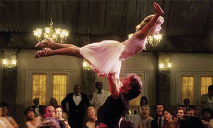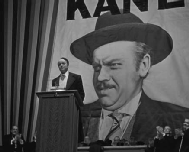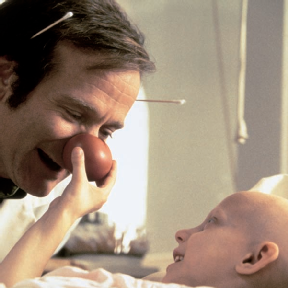 It's late February 2007, and NBC's hit sitcom "30 Rock" is in the process of skewering celebrity. Tracy Jordan, the star of the program's show-within-a-show, is hoping to add a sycophant or two to his entourage.
It's late February 2007, and NBC's hit sitcom "30 Rock" is in the process of skewering celebrity. Tracy Jordan, the star of the program's show-within-a-show, is hoping to add a sycophant or two to his entourage.
 It's late February 2007, and NBC's hit sitcom "30 Rock" is in the process of skewering celebrity. Tracy Jordan, the star of the program's show-within-a-show, is hoping to add a sycophant or two to his entourage. He and a crony, a fellow known as Dotcom, are considering options:
It's late February 2007, and NBC's hit sitcom "30 Rock" is in the process of skewering celebrity. Tracy Jordan, the star of the program's show-within-a-show, is hoping to add a sycophant or two to his entourage. He and a crony, a fellow known as Dotcom, are considering options:
"What's Young Larry doing these days?"
"He's in Jay-Z's entourage." "What about Cheese?" "He's rolling with Ghostface Killah now."
"Fat Balls?" "He's studying hotel administration at Cornell."
And so we have come to this: Cornell as punch line. Ba-dump-bump. But it's only the tip of the iceberg. Over the decades, you have probably spotted your alma mater in many places in fiction. You can find Cornell as setting, as plot device, as nuanced detail, as character study.
If film, television, and literature are to be believed, Ezra's grand experiment has produced, among other eccentric graduates, a mobster's son with a penchant for property fraud (in The Negative by Michael Covino), a hotel general manager in the fictional country of Absurdistan (in Gary Shteyngart's 2006 novel of the same name), a dice-shooting pro football player (in Ruffians by Tim Green), a socially challenged and sexually charged attorney (Lucy Liu's character on TV's "Ally McBeal"), a New York socialite forced into hiding after the murder of her husband (in An Invisible Woman by Anne Strieber), a celibate porn producer (in P, a novel by Andrew Lewis Conn '95), a disillusioned drug addict who sees ghosts (in World's End by T. C. Boyle), a crisis negotiator with the FBI (in the short-lived TV drama "Standoff"), an obese schizophrenic with an encyclopedic knowledge of low-budget horror movies (in The Ecstatic by Victor Lavalle '94), an archeologist who encounters a genie (in the Harlequin romance A Wish . . . and a Kiss by Margaret St. George), and a veterinarian in a traveling circus who rooms with a dwarf clown named Kinko (in Sara Gruen's Water for Elephants).
Characters with Cornell pedigrees have been played by a who's who of A-list movie stars—Charlton Heston, William Holden, Barbra Streisand, Glenn Close, James Woods, Renee Zellweger, Cameron Diaz. The university has made cameo appearances in films ranging from Love Story to Annie Hall to Diner to American Pie. Fictional Big Red grads have graced the small screen everywhere from "The Simpsons" to "The Office" and from "Caroline in the City" to "Sex in the City." They have found their way into numerous short stories, as well as the stage (Radio Golf by award-winning playwright August Wilson) and even online comic strips (Goats.com, the brainchild of Jonathan Rosenberg '95 and Phillip Karlsson '95).

One fictional alum even has eight fingers and green hair: Melvin van Horne, better known as Sideshow Mel, sidekick to Krusty the Klown on "The Simpsons." Revealed as a Cornell grad in the sixteenth season, he has been at the mercy of Krusty's sadistic sense of humor for more than a decade: struck in the head with an axe, kicked into a birthday cake, shot from a cannon. Once he even had liquid nitrogen poured down his pants. As he says, in his Shakespearian accent, "Any publicity is good publicity."
Faux Cornellians have been finding their way into literature, in particular, for more than a century—like The Common Lot (1904), From the Valley of the Missing (1911), and Extricating Obadiah (1917). They have been conjured up by the likes of Philip Roth (Letting Go), Mary Higgins Clark (Pretend You Don't See Her), and, rather prolifically, Joyce Carol Oates (in You Must Remember This, We Were the Mulvaneys, and a short story called "Life After High School").

Kay Scarpetta, who was for many years the fictitious chief medical examiner for the Commonwealth of Virginia, has sleuthed her way through fifteen novels by Patricia Cornwell. (The latest, Book of the Dead, was the seventh to enter the USA Today best-sellers list at Number One.) Scarpetta graduated from Cornell sometime around 1970, then earned an MD from Johns Hopkins and a JD from Georgetown. Since entering the public consciousness eighteen years ago (in Postmortem), the pathologist has investigated the deaths of everyone from a horoscope writer to a scuba diver.
Twice, even, fictional Cornellians have made their way to the Oval Office. Remarkably, in two very different novels you can read about two women—Florence Metzger in John Dalmas's The Second Coming and Harriet Styles in Robert Skidmore's self-published The Distracting Splat at the Eiffel—each having been elected the nation's first female president.
But Cornell-educated protagonists seem to be matched in nearly equal numbers by less desirable characters. For every Gabrielle Ashe (a U.S. Senator's aide who courageously ends her corrupt boss's career in Dan Brown's thriller Deception Point), there is a Bobby Earl (a rapist and murderer played by Blair Under-wood in the movie Just Cause). For every Eric Erickson, a Swedish industrialist who masquerades as a Nazi sympathizer to spy on the Germans during World War II in Alexander Klein's 1958 novel The Counterfeit Traitor (William Holden played him in the movie), there is a Taro Seki, a Japanese engineering grad who grew to love America while in Ithaca but changes his tune upon joining the Japanese army during that same war (in the propaganda film Behind the Rising Sun).
Sure, Cornell produced Xiao-Di, a character (in Terence Cheng's novel Sons of Heaven) inspired by the unknown Chinese student who stopped the tanks at Tiananmen Square—but it also gave the world Danny Haley, a small-time criminal and card sharp in the movie Dark City (played by Charlton Heston in his first major starring role). So there are heroes, and there are villains, and there are occasional shades of gray—like Prince Hrubal of Northern Transylvania (in Kingdom of Shadows by Alan Furst). On the plus side, he earned some fencing accolades during his two years on the Hill and is described as manically charitable. However, he also possesses "merciless eyes, black, depthless, and cruel." How would you like to room with him?
Sometimes, on film and television, the Big Red connection is simply conveyed visually. For instance, characters can be seen wearing Cornell sweatshirts in movies like Starman (a scientist) and 28 Days (a rehab resident). More directly, Cornell diplomas are prominently displayed on the office walls of Cameron Diaz's character in Any Given Sunday (she owns a fictional football team and boasts an MBA) and that of Mr. Rastatter, a sleazy executive played by Michael McKean (of "Laverne and Shirley" fame) in a 1995 episode of "Friends."
But more often, Cornell is included as an explicit part of the dialogue. In the movie Say Anything, an over-achiever tells a high school rival, "I know we were ultra-competitive this year, but I just want to say that if it wasn't for Diane Court, I probably wouldn't have gotten into Cornell because you made me study twice as hard. So thanks." On the other hand, in the classic Citizen Kane, a colleague of the title character (played by Orson Welles) explains, "Harvard, Yale, Princeton, Cornell, Switzerland—he was thrown out of a lot of them."


Indeed, a back story featuring a Cornell education often appears to be an obvious attempt to convey a certain intelligence. In The KGB Candidate by Owen Sela, Dr. Jonathan Bradley "read both Plato and computer manuals with equal facility." In Behind Closed Doors by Shannon McKenna, a millionaire's girlfriend is described thusly: "American citizen, degree from Cornell, summa cum laude, woo woo, smart cookie. Fluent in six languages, yada, yada . . ." In "Over There," a short-lived Iraq war drama on the FX channel, U.S. Army private Frank Dumphy, the intellectual of his platoon, was nicknamed "Dim" by his pals.
Often, too, references revolve around the challenge of admission to Cornell. In Black Night Bright Dawn, self-published by Gene Arthur Camerik, MBA '58, a young woman explains, "My parents are clearing the way for me to go to Cornell. You know, my dad's a Cornell grad who contributes to the alumni fund every year, and I've got the grades. I can't disappoint them." In Megan McCafferty's Second Helpings, the protagonist observes, "My only competition for valedictorian, Len Levy, has made it very clear that if he doesn't get into Cornell, he will drive up to Ithaca and hurl himself into one of its infamous suicide gorges." And in the 2004 movie The Perfect Score, a character tries to steal the SAT questions in an effort to earn a result worthy of the College of Architecture, Art, and Planning. In the end, he comes to an ethical epiphany and settles for Syracuse.
On the other hand, writers also tend to chide Cornell as the college that isn't in Cambridge. In the short story "Jim the Man," Herbert Gold writes, "As a student at Cornell, Jim had carried a green sack bulging with books because at Harvard they carried green sacks bulging with books." And in the movie Stella, Stephen Collins's character admits, "I had to fight with my parents to go to Cornell. They both went to Harvard and think Cornell is slumming it." (This is the same Stephen Collins who played cargo pilot Jake Cutter, also supposedly a Cornell graduate, in the short-lived 1980s television series "Tales of the Gold Monkey.")

But—and this may be the most interesting—Cornell also seems to be occasionally used to put an exclamation point on a character's odiousness. Neil, the smarmy grandson of the Catskills resort owner in Dirty Dancing? He attends the Hotel school. Nick Pepper, an obnoxious assistant on ABC's hit show "Ugly Betty"? He tells an equally unappealing mentor, "I've been following your career since I graduated from Cornell."
Perhaps the best example of this comes from NBC's Emmy-winning sitcom "The Office." Andy Bernard, played by actor Ed Helms, is a sycophantic blowhard who works at the Scranton branch of the Dunder Mifflin Paper Company and uses every opportunity to pompously remind everyone, "I went to Cornell . . . Ya ever heard of it?" It is an integral element of his character, a means of revealing his insecurity while trumpeting his self-importance. Rarely an episode goes by without a reference:
Andy (to the camera): "I never studied once. I was drunk the whole time. And I sang in the a capella group Nothing But Treble."
Andy (to the camera): "I graduated from anger management the same way I graduated from Cornell—on time."
Andy (to his boss): "I forgot to tell you the plan for this Saturday. You, me, bar, beers, buzzed. Wings, shots, drunk! Waitresses—hot! Football, Cornell-Hofstra, slaughter!"
Andy (to his colleague, Jim): "I started the main Frisbee golf club at Cornell, where I went to college. I live to frolf!"
Jim (to Andy): "Where did you go to school again?"
His co-workers can't stand his Big Red references. Then again, they didn't go to Cornell.
Prop Master
Furnishing Hollywood with Big Red swag

From 1986 until his retirement in 2000, David Stewart served as Cornell's first full-time director of community relations. Among his responsibilities: overseeing the product licensing program for the University and fielding inquiries from television and film production companies. In that role, he sent various diplomas, yearbooks, campus photos, and apparel to the sets of such movies as Patch Adams, City of Angels, Contact, and Deep Impact. "We became known to certain production companies or prop departments, who then would call back a second or third time," says Stewart.
This may be because many other schools were charging hefty use fees. However, Cornell charged only shipping costs. "We're more likely to get subsequent requests that way—and therefore more exposure," Stewart explains. "It's part of getting the University's name out there—in a positive light, obviously. So we would get copies of the script to see how that character was being referenced." On the TV show "Nash Bridges," for instance, the daughter of the hero was considering colleges. Stewart sent Cornell's view book, which happened to be taller than most of the others. "So in the scene where she's applying to colleges, she's carrying several brochures," says Stewart, "but the Big Red Book stands out above the others—big, bold, and beautiful."
Occasionally, Stewart's efforts would find their way only to the cutting room floor, such as in the movie Mother, starring Albert Brooks and Debbie Reynolds. Stewart sent several props, including an authentic freshman beanie. But at the last minute, the director chose to have Reynolds's character attend another college. Likewise, Stewart had several discussions with Robert Redford's production company when he was filming The Horse Whisperer. But in the end, the novel's frequent mention of Cornell was noticeably absent from the movie.
On the other hand, the book The Prince of Tides makes no mention of Cornell. But in the film, Barbra Streisand's character has a Cornell diploma on the wall, seen in the background of an office shot. "Soft focus, but it's there," says Stewart. Of course, Stewart had to make sure the diploma couldn't be used to indicate a real degree—that is, they couldn't have the actual university president's signature. So, he says, "I signed it myself."

Inspiration, via Ithaca
What's behind all those Cornell references?
For some authors, giving a character a Cornell pedigree is simply a matter of referencing—or skewering—the old alma mater (e.g., Cat's Cradle by Kurt Vonnegut '44, The Crying of Lot 49 by Thomas Pynchon '59, Miss Match by Leslie Carroll '81, and Fool on the Hill by Matt Ruff '87). The Big Kids, a novel by Robert Hennemuth '77, explores the transition from adolescence to adulthood during a romp through freshman year on the Hill in 1973. In A Thing (Or Two) About Curtis and Camilla by Nick Fowler '89, the protagonist—like the author—is a native of north Florida, a Cornell graduate, and a rock musician.

Linda Tatelbaum '68, PhD '72, self-published a novel, Yes & No, about a late-Sixties Cornell graduate student named Naomi Weiss who journeys to Paris to unlock the secret behind twelfth-century philosopher Abelard and his lover, Heloise. "I know Cornell best, so why would I make up a fictional university?" says Tatelbaum, retired from the faculty at Colby College. In Goats.com, the pioneering Web comic that cartoonist Jonathan Rosenberg '95 describes as "everything you want to see in a comic all mashed together in a sci-fi comedy epic," the main characters have been seen waiting in line for the Hot Truck and drinking beers at the Chapter House. Says Rosenberg, "Cornell is mostly used as flavor. It's not incredibly central to the plot."
Still, writers tend to insist that there is no impulsiveness involved in the inclusion of backstory details. "Whims are kind of hazardous," says Jack Henderson, author of the thriller novel Circumference of Darkness. "It's too easy to make a mistake with an offhand reference that sounds perfectly correct in passing, but is a glaring embarrassment in the eyes of a knowledgeable reader." Henderson's central character, Jeannie Reese, is a twenty-two-year-old Department of Defense computer genius who has developed anti-terrorist surveillance technology. She was a chess grandmaster at age six. She graduated from Cornell at twelve. She is a martial arts expert and a babe. She basically saves the world. "For someone like Jeannie, details like where she went to school would be character-defining points, so I absolutely put more time and thought into making those choices," says Henderson. "In addition to the school's prestige, the look and atmosphere of Cornell just seemed right for Jeannie. I liked the fact that it's the youngest of the Ivy League universities. But Cornell's ground-breaking role in the field of cybernetics was probably the most important consideration."

Cornell-educated characters have been included in books that take place in the Philippines (Dread Empire by Linda Ty-Casper), a village in rural India (Shiva Dancing by Bharti Kirchner), Communist East Germany (Crossing in Berlin by Fletcher Knebel), and the wild, wild West (Separations by Oakley Hall). But at times Cornell's campus itself plays a larger role when the author includes descriptive details to add to a sense of place, as when a character in The Salt Point by Paul Russell, MFA '82, PhD '83, describes Collegetown as "that student ghetto across the gorge from the university's meticulous lawns." Says Henderson, regarding Circumference of Darkness, "A quick, recognizable landmark was necessary for a certain bit of description, and McGraw Tower was ideal for that." The setting may also be chosen in association with character development. In Kingdom of Shadows, Alan Furst made Cornell the alma mater of Prince Hrubal of Transylvania because "he would have had no idea where exactly he was going, and he would have been surprised to find himself in Ithaca."
Occasionally, too, the setting fits the plot—like in The Horse Whisperer. "The horse accident at the start of book takes place in Upstate New York, and I sent [veterinarian] Harry Logan to Cornell simply because it seemed plausible," says author Nicholas Evans. "I researched veterinary schools in that part of the world, and there really was no contest." Logan attended Cornell in the late Sixties. Upon his return years later, he observed, "It was about the prettiest campus he knew. But not today. It was cold and starting to rain and you couldn't even see the damn lake." Clearly, Evans visited Ithaca for research, right? Not exactly. "I had no contacts at Cornell and never went there," he admits. "I just blindly phoned the school and was graciously helped with all my dumb questions."
Labor of Love
A trip to the planet Noron
 In Shane Johnson's The Last Guardian, T. G. Shass, a graduate student on the Hill, finds himself in possession of a mysterious artifact that happens to hold the Creator's divine truth. He meets a Christ-like figure, is transported to the planet Noron, defeats the forces of darkness, and enjoys eternal paradise. Johnson is the author of the book, but not of the original concept. That was created by Dan Cheney '81, whom Johnson met as a fellow Texas teenager in 1975.
In Shane Johnson's The Last Guardian, T. G. Shass, a graduate student on the Hill, finds himself in possession of a mysterious artifact that happens to hold the Creator's divine truth. He meets a Christ-like figure, is transported to the planet Noron, defeats the forces of darkness, and enjoys eternal paradise. Johnson is the author of the book, but not of the original concept. That was created by Dan Cheney '81, whom Johnson met as a fellow Texas teenager in 1975.
Cheney wrote a sixteen-page high school creative writing assignment called "The Open Door," a science fiction tale featuring a time-traveling college student. The class assignment evolved into a manuscript called The Noron Event, and the project soon became a joint effort between Cheney and Johnson. They were separated by thousands of miles in their college years, so the collaboration moved slowly. But in the spring of 1978, Cheney insisted they complete the book. He arranged to carpool from New York to Texas, he and his fellow students taking turns driving around the clock. But on the early morning of May 23, the car crashed on a two-lane highway in Ohio. Only the driver survived. Cheney had been asleep in the backseat.
A few days later, Johnson received a package postmarked from Ithaca. It was the manuscript—the only copy, with handwritten notes and a cover letter in which Cheney expressed a desire to take the tale in a different direction. "[He] told me to feel free to make any changes I thought would make it better," Johnson writes on his website. "I knew at that moment that the best and truest way to honor the memory of my dear friend was to finish the book we had started."
It took years. Johnson married, had a son (whom he named Daniel), and published several other books. Finally, he felt it was time to return to the manuscript. It was published in 2001, only now it was titled The Last Guardian, and its hero attended Cornell.


